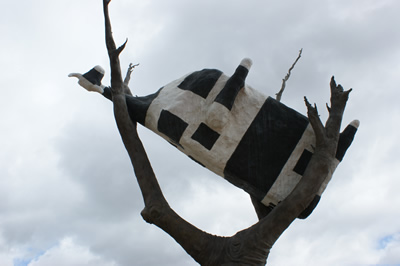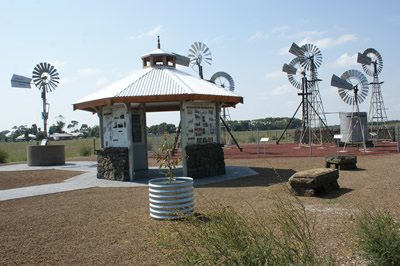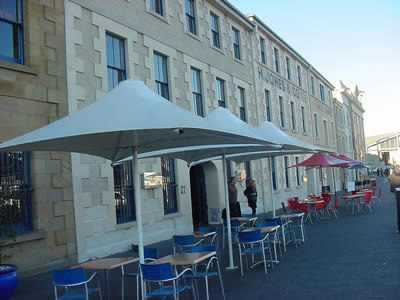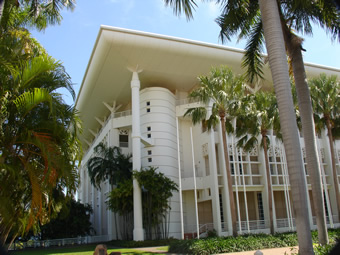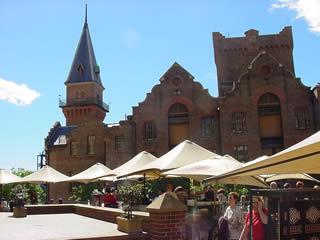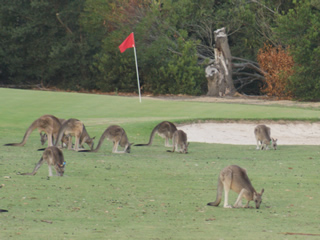One of the more intriguing pieces of art in Melbourne’s Docklands precinct is Cow Up a Tree, a sculpture by artist John Kelly. The cow was originally created for a sculpture exhibition in Paris on the iconic Champs-Élysées to celebrate the millennium in 2000. In 2003, the Cow Up a Tree sculpture was installed overlooking Victoria Harbour, where it has since become a much-loved icon of Melbourne’s thriving Docklands precinct. Read the rest of this entry »
Posts under ‘Australia’
Beeac Heritage Windmill Park
Today we travel to the Western District of Victoria Australia to what is one of the more unique roadside attractions we have come across. Beeac is a tiny country town with a rich farming heritage especially in dairy. This park celebrates the engineering of some of the magnificent windmill that have served the surrounding district over the last 150 years. The windmill has been played an important part in Australian farming heritage pumping water to dams for stock and crops. The Prowse Windmill is one of the more impressive in the park and dates back to a business ran by James Prowse which began in 1988. The windmill on display has an impressive 6ft wheel and used to bring water from close the surface. The windmills have been found by volunteers and restored as faithfully as they can be using photographs and drawings of the originals and now stand as a tribute and testament to life on the land.
Salamanca Place Hobart
Today we travel to Australia to the little island of Tasmania and visit its capital Hobart. Down on Hobart’s beautiful waterfront is Salamanca Place. This was once a bustling port area and the sand stone buildings were warehouses. As the modernisation changed the way the ports operated the buildings have slowly been transformed into new uses. The area today is one of Hobart’s best tourist destinations with the row of buildings now galleries, hotels, cafes and gift shops. The precinct is home to many of the city’s events and a great market is held along the strip on Saturdays selling a wealth of locally grown produce, food, giftware and other items. 300 stalls are not an uncommon sight on most Saturdays and crowds of up to 25000.
Bendigo’s Sacred Heart Cathedral
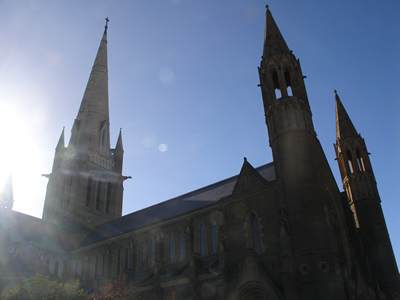
The goldfields city of Bendigo in Victoria Australia is home to one of the country’s finest cathederals, The Sacred Heart Cathedral. Built using a Gothich Revival style and designed by William Tappin the groundbreaking was in 1897 but the cathederal was not completed for some 80 years in 1977. The Roman Catholic church. The sandstone for the building was mined from near Geelong (the home of Tripandom). Sacred Heart Cathedral is 75 metres long and has a ceiling height of 24 metres. The main spire is 87 metres high and was the last piece to be constructed using a lighter steel frame and masonary veneer than the original plans had specified to cut weight and cost. Another highlight of the cathederal is the large pipe organ, built by Bishop & Son of London, was installed in 1905.
Darwin’s tropical parliment
Darwin’s Parliament House is home to the Northern Territory Legislature and is one of the city’s more striking pieces of architecture. Opening in August of 1994 this building has been designed to suit Darwin’s tropical and sometimes harsh environment. The huge facade screens up to 8-% of the direct sunlight to the interior of the building and specially selected interior features including Tasmanian timbers and special fittings also help keep the building suitable for the many office workers and ‘most importantly’ the politicians. The building is open for self guided tours most days and there are guided tours certain times of the year. School tours are very popular and are a great way for the young to understand how and why the parliament operates. The building overlooks the beautiful Darwin Harbor and is located on land which was once occupied by the Larrakia Aboriginal People. To the west of the parliamentary building is Speaker’s Green which is a very popular place for weddings in Darwin. Just about every weekend you will see newly weds having their photographs taken or taking part in their ceremony. Towards the southern end of the green you will find Government House which amazingly survived both the bombing of Darwin in World War II and the horrific Cyclone Tracy of Christmas Day 1974. The lush gardens and tropical architecture make this one of the jewels of Darwin.
Sydney Rocks
When we think of Sydney Australia we think about the beautiful Opera House and the Sydney Harbor Bridge but one of the jewels of the city and and one of the most popular tourist attractions are the Sydney Rocks. The Rocks is a historic precinct not far from the Harbor Bridge and the Circular Quay precinct. The Rocks date back to pretty much English settlement of Sydney in 1788 when the area quickly became a hive of activity with pubs and lodging and a bustling port trade. Drinking and gaming was soon followed by prostitution and other forms of illigal activities. The area became a wasteland in the early 1900’s with the city moving on leaving the Rocks behind to decay. The building of the Bridge regained interest in redeveloping the area but World War II stalled the plan and the area became even more run down. During the 1960’s the government planned to turn the area into a modern showcase of concrete and glass skyscrapers, this got the public off side and many sought to fight for the heritage of the area. The people won over development and slowly the area was rebuilt and restored into a jewel of the city. Today the rocks is a historic collection of great old pubs, cafes, restaurants, galleries and many other tourist based industries. The area is popular for its weekend craft markets and many of the city’s events it is a must see for anyone visiting Sydney.
Teeing off with a roo
Anglesea on Australia’s Great Ocean road only minutes from Geelong in Victoria is home to one of the world’s most unique golf courses. The greens are shared by golfers and hundred’s of Australia’s national symbol the Kangaroo. These delightful grey kangaroos gracefully hop around the course picking the lush greens not giving a second thought for the golfers or the balls flying across the green. The Anglesea Golf Club is surrounded by bushland which is the perfect habitat for kangaroos and everyday they come onto the green for a nibble or maybe just a lay in the sun. The kangaroos usually don’t give the golfers much problem but they are sometimes not as cute and cuddly as they look they have very sharp claws and extremely strong rea legs and have been known to inflict serious injury on people when alarmed. Kangaroos like many of Australia’s other unique animals are best viewed at a distance.
Cockatoo Island
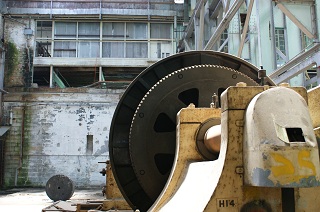 For magnificent views of Sydney Harbour and a interesting look back at some of Australia’ s most important manufacturing heritage Cockatoo Island is a must for someone looking for something a bit different to do in this beautiful waterfront city. Cockatoo Island is the largest island within Sydney Harbor and is managed by the Sydney Harbour Federation Trust. This island as well as being a prison and a range of other things the island has been the site of one of the country’s biggest shipyards. Today many of the industrial and convict past remains and they offer an amazing insight into the past. The historic sandstone prison buildings have even been nominated for World Heritage Protection. The island is easily accessed from ferry and there are luxury campsites offering one of the best views of Sydney. The island is a perfect place to kick back and watch the harbor sites and escape the hustle and bustle of one of the world’s great cities.
For magnificent views of Sydney Harbour and a interesting look back at some of Australia’ s most important manufacturing heritage Cockatoo Island is a must for someone looking for something a bit different to do in this beautiful waterfront city. Cockatoo Island is the largest island within Sydney Harbor and is managed by the Sydney Harbour Federation Trust. This island as well as being a prison and a range of other things the island has been the site of one of the country’s biggest shipyards. Today many of the industrial and convict past remains and they offer an amazing insight into the past. The historic sandstone prison buildings have even been nominated for World Heritage Protection. The island is easily accessed from ferry and there are luxury campsites offering one of the best views of Sydney. The island is a perfect place to kick back and watch the harbor sites and escape the hustle and bustle of one of the world’s great cities.
The Old Geelong Gaol
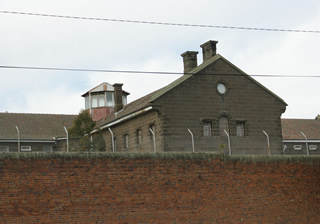 The Old Geelong Gaol is a former gaol that was built in stages from 1849 to 1864 and used until 1991 when the prisoners made way for tourist at this rather creepy old building. Originally known as HM Prison Geelong the gaol is located in Geelong about an hour’s drive from Melbourne in Victoria, the building is a large bluestone structure that was built by the prisoners themselves and shaped in a cruciform, a design taken from North London’s Pentonville Prison. A cold and spooky place the building has seen its fair share deaths over the years either from disease or natural causes or from prisoners who committed suicide after they were sent insane by its solitary confinement or were hanged for their crimes. Today many of the visitors to gaol report a spooky presence in the building and several research groups have studied the site for paranormal activity. Read the rest of this entry »
The Old Geelong Gaol is a former gaol that was built in stages from 1849 to 1864 and used until 1991 when the prisoners made way for tourist at this rather creepy old building. Originally known as HM Prison Geelong the gaol is located in Geelong about an hour’s drive from Melbourne in Victoria, the building is a large bluestone structure that was built by the prisoners themselves and shaped in a cruciform, a design taken from North London’s Pentonville Prison. A cold and spooky place the building has seen its fair share deaths over the years either from disease or natural causes or from prisoners who committed suicide after they were sent insane by its solitary confinement or were hanged for their crimes. Today many of the visitors to gaol report a spooky presence in the building and several research groups have studied the site for paranormal activity. Read the rest of this entry »
Have a Picnic at Hanging Rock
A popular tourist spot 1 hour north of Melbourne Hanging Rock is located off the Calder Highway and is well know for the 1975 Peter Weir film “Picnic at Hanging Rock†that was one of the first Australian films to receive international acclaim. The film itself was based upon the 1967 Joan Lindsay novel of the same name that tells the story of three girls and a teacher who mysteriously disappear during a St Valentines day picnic at the rock in 1900. The way Lindsay wrote the book many people still believe the events of the picnic are true but in fact the whole story was fictional. The story created a unique tourist draw card to the area with plenty of people wanting to experience the mystery of the rock. Several annual events are held at the rock each year with the races being on New Years Day, Australia Day and Labour Day. February being the month St Valentine’s day falls in also brings a lot of special events to the rock like the “Picnic at Hanging Rock†film night, The Harvest Picnic and a classic car show. During the summer months guided night walks are also conducted around the rock. The video above is the trailer for the film “Picnic at Hanging Rock”. Read the rest of this entry »

